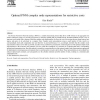Free Online Productivity Tools
i2Speak
i2Symbol
i2OCR
iTex2Img
iWeb2Print
iWeb2Shot
i2Type
iPdf2Split
iPdf2Merge
i2Bopomofo
i2Arabic
i2Style
i2Image
i2PDF
iLatex2Rtf
Sci2ools
COMCOM
2004
2004
Optimal PNNI complex node representations for restrictive costs
The Private Network-to-Network Interface (PNNI) is a scalable hierarchical protocol that allows ATM switches to be aggregated into clusters called peer groups. To provide good accuracy in choosing optimal paths in a PNNI network, the PNNI standard provides a way to represent a peer group with a structure called the complex node representation. It allows the cost of traversing the peer group between any ingress and egress to be advertised in a compact form. Complex node representations using a small number of links result in a correspondingly short path computation time and therefore in good performance. It is, accordingly, desirable that the complex node representation contains as few links as possible. In earlier work, a method was presented for constructing the set of the optimal complex node representations in the restrictive and symmetric cost case, under the assumption of a restricted set of optimal paths and a corresponding minimal path computation time. Here this method is exte...
Related Content
| Added | 17 Dec 2010 |
| Updated | 17 Dec 2010 |
| Type | Journal |
| Year | 2004 |
| Where | COMCOM |
| Authors | Ilias Iliadis |
Comments (0)

